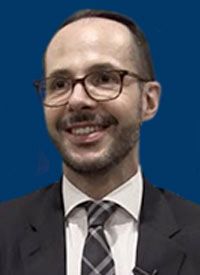Bendamustine Plus Rituximab Shows Promise as Induction Therapy in Mantle Cell Lymphoma
Diego Villa, MD, MPH, discusses the benefit of bendamustine and rituximab versus R-CHOP in transplant-eligible and -ineligible patients with mantle cell lymphoma.
Diego Villa, MD, MPH, a clinical associate professor in the Division of Medical Oncology, Department of Medicine, The University of British Columbia

Diego Villa, MD, MPH
The combination of bendamustine and rituximab (Rituxan; BR) was found to be an effective induction regimen in patients with mantle cell lymphoma (MCL), irrespective of transplant eligibility, according to data from a single-center, retrospective analysis presented at the 2019 ASH Annual Meeting.1
Historically, BR had been used as the preferred induction regimen in transplant-ineligible patients with MCL. Following results from the phase III StiL-1 trial, BR demonstrated favorable responses rates and a progression-free survival (PFS) benefit compared with R-CHOP.2 However, the regimen had never been evaluated in transplant-eligible patients, according to lead study author Diego Villa, MD, MPH.
“In mid-2013, we made an institutional decision to treat all patients with upfront BR, regardless of transplant eligibility,” said Villa. “The analysis shows that you can achieve excellent response rates when you treat all-comers with BR.”
Among 190 patients treated with BR, 101 (54%) achieved a complete response (CR) and 62 (33%) achieved a partial response. Of 89 patients ≤65 years of age, 60 (67%) underwent autologous stem cell transplant (ASCT) and 29 (33%) did not. Of the remaining 101 patients >65 years of age, 9 (~9%) underwent ASCT and 92 (91%) did not.
At a median follow-up of 2.4 years, the 3-year overall survival (OS) and PFS rates with BR were 69.5% (95% CI, 69.4-70.6) and 62.8% (95% CI, 62.4-63.6), respectively. While BR was associated with a numerical improvement in PFS compared with R-CHOP in the subgroup of patients ≤65 years of age, differences in PFS and OS between the arms were not determined to be statistically significant.
Additionally, 23 (12%) patients progressed during or within 3 months of completing BR and all had highly proliferative disease characterized by Ki-67 ≥30% or blastoid/pleomorphic histology, suggesting that the regimen may not be suitable for those with more aggressive disease.
In an interview with OncLive, Villa, a clinical associate professor in the Division of Medical Oncology, Department of Medicine, The University of British Columbia, discussed the benefit of BR versus R-CHOP in transplant-eligible and -ineligible patients with MCL.
OncLive: Could you provide the rationale for the study?
Villa: The rationale for this study came from the STiL-1 trial, in which BR showed excellent response rates and PFS compared with the previous standard, R-CHOP. However, it's important to note that that particular study was done in transplant-ineligible patients. The question of whether to use BR in transplant-eligible patients [was still unknown].
What were the results of the retrospective analysis?
This retrospective analysis [reflects] our institutional experience [with] treating patients with BR over the past 6 years or so. In our analysis, the overall response rate was 87% and the CR rate was 54%. We found no difference in response rates between patients over the age of 65 or under the age of 65.
It is important to highlight that 23, or 12%, of our patients developed progressive disease on or within 3 months of completing BR. When we looked at who these patients are, we found a number of high-risk features, including aggressive biology, blastoid and pleomorphic histology, as well as elevated Ki-67. This suggests that patients with highly proliferative disease should be considered for other therapies.
How do these results compare with historical response rates with R-CHOP?
We did not look specifically at responses to R-CHOP in our analysis, but in looking at the published literature, these figures compare favorably with [what we have seen with] R-CHOP. Our results are certainly in line with data that have been published previously with BR versus R-CHOP.
Do these results suggest that BR can be used upfront regardless of transplant eligibility?
Our study definitely supports the use of BR in the transplant-ineligible population. Our study is pretty much in line with the STiL-1 data, which showed improved PFS with BR compared with R-CHOP. Our study suggests there might be an OS improvement [with BR], although we included patients treated with cyclophosphamide, vincristine, prednisone, and rituximab, as that was part of our previous standard.
In terms of transplant-eligible patients, our study suggests that BR is an effective induction regimen. There is no defined standard of care in the literature for frontline therapy in transplant-eligible patients with MCL. Our study suggests that this could be a reasonable alternative for some patients. In general, BR is better tolerated than R-CHOP. There are advantages to BR. For example, BR does not cause alopecia, peripheral neuropathy, or severe nausea and vomiting, [which are typically] associated with R-CHOP.
How will these data impact practice?
I believe it is safe to say that BR is a reasonable backbone for frontline therapy of [patients with] MCL across the board. However, this needs to be further evaluated in a randomized prospective fashion. The ECOG-ACRIN 4181 trial is currently using the BR backbone and testing the addition of cytarabine and/or acalabrutinib (Calquence) to this chemotherapy backbone.
References
- Villa D, Sehn LH, Savage KJ, et al. Bendamustine and rituximab as induction therapy in both transplant eligible and ineligible patients with mantle cell lymphoma. Blood. 2019;134(suppl 1): 2814. doi. 10.1182/blood-2019-124217.
- Rummel MJ, Niederle N, Maschmeyer G, et al. Bendamustine plus rituximab versus CHOP plus rituximab as first-line treatment for patients with indolent and mantle-cell lymphomas: an open-label, multicentre, randomised, phase 3 non-inferiority trial. Lancet. 2013;381(9873):1203-1210. doi: 10.1016/S0140-6736(12)61763-2.